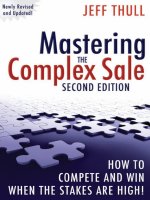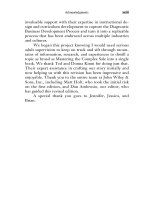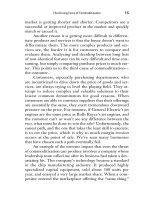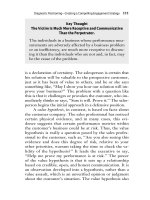Mastering the Complex Sale to Compete and Win_1 doc
Bạn đang xem bản rút gọn của tài liệu. Xem và tải ngay bản đầy đủ của tài liệu tại đây (354.79 KB, 24 trang )
E1FLAST01 02/04/2010 Page 23
invaluable support with their expertise in instructional de-
sign and curriculum development to capture the Diagnostic
Business Development Process and turn it into a replicable
process that has been embraced across multiple industries
and cultures.
We began this proj ect knowing I would need serious
adult supervision to keep on track and sift through moun-
tains of information, research, and experiences to distill a
topic as broad as Mastering the Complex Sale into a single
book. We thank Ted and Donna Kinni for doing just that.
Their expert assistance in crafting our story initially and
now helping us with this revision has been impressive and
enjoyable. Thank you to th e entire team at John Wiley &
Sons, Inc., including Matt Holt, who took the initial risk
on the first edition, and Dan Ambrosio, our editor, who
has guided this revised edition.
A special thank you goes to Jennifer, Jessica, and
Brian.
Acknowledgments xxiii
E1FLAST01 02/04/2010 Page 24
E1CINTRO 02/03/2010 Page 25
Introduction to the Second Edition
V
alue remains the most sought after and least under-
stood factor in the world of complex sales. Companies
continue to invest in high-value solutions designed to solve
thei r customers’ problems, fuel profitable growth, and set
them apart from their competitors. They also continue
to struggle with the pressures of complexity and com-
moditization, which have escalated since I wrote the first
edition of Mastering the Complex Sale, and while I work
with business-to-business companies around the world.
Their challenges in today’s volatile markets—and the
focus of my work—can be summarized in two words: value
clarity. C ompanies are finding it increasingly difficult to
defend their value in the marketplace because it is increas-
ingly difficult to connect that value to customers’ situations
and quantify it. The more complex customers’ situations
and the solutions that can address them are, the more un-
certain customers become. This uncertainty manifests in
decision paralysis: The percentage of sales opportunities
ending in no d ecision at all is running well above 35 per-
cent for most business-to-busines s sellers. Th e conse-
quences o f this dismal reality include lost revenues, long
sales cycles, and unpredictable outcomes. Customer uncer-
tainty is consuming a n alarmingly high percentage of
company resources.
xxv
E1CINTRO 02/03/2010 Page 26
To put it bluntly, because business-to-business sellers
areunabletoprovidetheircustomers with value clarity,
they cannot defend their value. As a result, they have no
alternative but to cut prices, which requires cutting costs to
maintain margins. This can lead to a very dangerous down-
ward spiral, in which the organic growth and profits re-
quired t o sustain their businesses sp in further and further
out of their reach.
Value clarity defeats uncertainty, and this book is de-
signed to equip you with the organizational capability
needed to create value clarity and decisiveness both within
your company and on the part of your customers.
I remain convinced that Diagnostic Business Develop-
ment
1
is the best way to create, connect, quantify, and de-
liver customer value in the current era. Conventional sales
approaches, which were designed for simpler times and
transactio ns, cannot manage the escalat ion in complexity,
customer requirements, commoditization, and competition
that sales professionals everywhere are facing. C ertainly,
doing more of something that isn’t working in the first
placeisn’tthewaytocompetemoreeffectivelyandwin
more sales.
Business-to-business companies need a smarter way to
bring their value to market and transform it into profitable
growth. They need a platform that is specifically designed
for the complex sales arena, one that o ffers a system a nd
theskillsandthementaldiscipline needed to execute it.
Diagnostic Business Development is this smarter w ay to
sell because it converts the conventional solutions-based,
seller-first approach into a diagnostic, customer-first
approach. It eliminates obsolete sales processes driven by
premature presentations, debate, and confrontation, and
replaces them with a step-by-step process of mutual con-
firmation between the sales team and the customer. It
transforms the customer’s stereotypical impression of
xxvi INTRODUCTION TO THE SECOND EDITION
E1CINTRO 02/03/2010 Page 27
salespeople as predators into one in which sale speople are
seen as valued business part ners who bring credibility, in-
tegrity, and dependability to the business relationship.
In short, Diagnostic Business Development is a smar-
ter way to sell because it enables sales professionals to stop
selling in the conventional sense. Instead, the sales engage-
ment becomes a guided decision process in which salespeo-
ple work with customers to Discover, Diagnose, Design,
and Deliver the highest-value solution to their problems.
Diagnostic Business Development enables us to:
Get beyond selling to managing decisions. All good
salespeople have a sales process and all customers have
a buying process. The problem is that they invariably
have conflicting objectives that create an adversarial
relationship. We need to set aside confrontational
processes and replace them with a collaborative deci-
sion process, provided by the sales professional.
Get beyond problem solving to facilitating change.
Providing quality solutions to customer problems no
longer ensures a successful sale and certainly does
not guarantee a successful implementation. Change,
along with all the attendant risks involv ed, is the key
issue that customers face. We need to help th em un-
derstand, prepare for, and navigate the change required
to ensure the successful implementation of our solu-
tions, achieve the value they are expecting, and measure
the value they have achieved.
Get beyond meeting needs to managing expectations.
Just because we see a need does not mean that our cus-
tomers se e it or understand it as clearly as we do and
will do something about it. We need to clarify our
value by connecting it to our customers’ performance
metrics and qua ntify our value impact with a number
our customers believe. Further, we must clarify our
Introduction to the Second Edition xxvii
E1CINTRO 02/03/2010 Page 28
customers’ expectations about solutions in a manner that
brings them the confidence to invest in our solutions.
Get beyond transactions to managing relationships. In
the rush to close deals, we too often forget the human
factor and squander the long-term opportunity. We
need to address the hopes, fears, and aspirations of our
customers and create mutually beneficial relationships.
Get beyond rote talking points and ‘‘value messages’’
to rich, interactive conversations. Too often, we react
to customers with fixed responses, without asking for
clarification or deeper thinking. As a result, we sound
just like every other salesperson. We need to commu-
nicate at a level that fosters a crystal-clear, mutual
understanding of our customers’ challenges and objec-
tives in order to provide them with the best solutions.
It struck me, as I began working on this new edition,
how much the Diagnostic Business Development platform
has evolved since the first edition. Since then, I’ve written
two additional books. The Prime Solution is a strategic view
written for senior leadership teams who want to understand
how Diagnostic Business Development can be used to
bridge the value gap that exists between them and their
customers. Exceptional Selling is a practical guide to the art
and craft of diagnostic conversations w ritten for sales
professionals who are seeking to become valued business
advisors to their customers. Both projects have enabled me
to expand and refine the ideas in this book.
My clients have also stimulated my thinking and I’m
very grateful to them for it. We continue to teach and sup-
port the implementation of Diagnostic Business Develop-
ment on a global stage, and it is fascinating to see how the
talented executives and sales professionals in these compa-
nies have extended and adapted the ideas in this book to fit
their unique situations. Because of all of this, this edition of
xxviii INTRODUCTION TO THE SECOND EDITION
E1CINTRO 02/03/2010 Page 29
Mastering the Complex Sale contains a great deal of new and
street-tested information.
We’ve developed powerful approaches to value clarity
during the past few years and they play a much more
central role in this edition. I first formulated the Value Life
Cycle
TM
concept in my second book, and now it is expanded
and woven into the Diagnostic Business Development plat-
form. As a result, you will be able to help your customers
clarify, connect, and quantify value in a manner that will
clearly set you apart from your competition.
Individual sales professionals can read this book and
use it to improve their results exponentially, but it has far
greater potential when developed as a capability by sales or-
ganizations and their companies. Implementing Diagnostic
Business Development in an integrated manner in the sales
organization can raise the performance level in a significant
percentage of the sales force. Better yet, as evidenced by
clients of my firm, companies that embed Diagnostic Busi-
ness Development as an organizational capability can opti-
mize their value chains, creating a value-driven company in
the process. Wayne Hutchinson’s foreword, with its de-
scription of Shell Gl obal Solutions’ success, provides a
clear picture of the results you can achieve if you decide to
build a Diagnostic Business Development capability across
your entire business.
Finally, this new edition contains myriad refinements
and additions to the Diagnostic Business Development
platform that will provide first-time readers with a more
comprehensive introduction. It will also provide a richer,
more nuanced understanding to the tens of thousands of
you who made the first edition of Mastering the Complex
Sale the leading sales strategy book of the past decade.
In fact, many of the changes in this new edition were stimu-
latedbythequestionsyouaskedandthecommentsyou
made in our consulting engagements and seminars.
Introduction to the Second Edition xxix
E1CINTRO 02/03/2010 Page 30
On that note, I’d like to thank every sales professional
and executive who contributed to this book—from new re-
cruits wondering how to best frame that first call, to the
sales veterans who are fine-tuning their diagnostic skills;
from the line managers who are working hard to meet and
beat their targets, to senior executives who are trying to
convert customer value to profitable gr owth. You ar e the
pri mary motivation behind this book a nd almost 30 years
of work focused on mastering the complex sale. Enjoy the
read! Enjoy your journey!
xxx INTRODUCTION TO THE SECOND EDITION
E1CINTRO 02/03/2010 Page 31
Mastering
the
Complex Sale
Second Edition
E1CINTRO 02/03/2010 Page 32
E1C01 02/02/2010 Page 1
I
The World in Which We Sell
E1C01 02/02/2010 Page 2
E1C01 02/02/2010 Page 3
1
Caught betwee n Complexity
and Commoditization
If Our Solution Is So Complex, Why Is It Treated
as a Commodity?
E1C01 02/02/2010 Page 4
E1C01 02/02/2010 Page 5
T
he frustration triggered by this chapter’s title is shared
by a large number of executives, marketers, and sales
professionals who are taking their complex, high-value
solutions to market and finding it increasingly difficult to
win profitable sales. Ironically, it is also shared by their
customers, who a re wrestling with mission-critical deci-
sions, evaluating solutions that all sound the same, and
struggling to achieve the value they expect, when experi-
ence has shown them that far too many solutions come
packaged with a high degree of risk a nd a low probability
of success. This phenomenon places all of us clearly in the
third era of sales.
This is an era i n which customers are not saying,
‘‘I need a solution!’’ They know they can get comparable
solutions from c redible sources.Instead,theyaresaying,
‘‘I need help!’’
‘‘I need help in making multiple decisions around this
purchase.’’
‘‘I need help in quantifying the busine ss impact of this
project to make sure it is the best use of my resources.’’
‘‘I need help in getting my organization to align around the
implementation and make the changes required to optimize
the value of your solution.’’
‘‘I need help to show measurable results.’’
Are you equipped to help your customers in Era 3? It
seems, at first glance, like a strange question, but it’s essen-
tial that it be examined more closely. The question is valid
because most businesses are applying sales strategies, pro-
cesses, collateral, and skills originally designed for a world
that no longer exists.
5
E1C01 02/02/2010 Page 6
John Sullivan, my colleague and director of profes-
sional services for Prime Resource Group, wrote about the
three eras of selling in the foreword to the first editi on of
this book.
1
He described the Era 1 approach with its focus
on cold calling, presenting, and closing, and a strong dose
of overcoming objections. Salespeople were taught to be
persuaders (some would call them pests). I like to describe
it as the age of ‘‘show and tell,’’ ‘‘spray and pray,’’ ‘‘cram
and jam,’’ and ‘‘grab ’em by the tie and choke ’em ’til they
buy.’’ Salespeo ple didn’t ask customers many questions at
all; they told them what to do and they did it in a very ag-
gressive manner. These Era 1 tactics are the source of the
common sales stereotypes that live in the minds of many
people today. They provided the major impetus behind the
creation of procurement systems designed to counteract
aggressive sales tactics and protect customers from buying
the wrong thing or paying inflated prices.
The sales profession worked to redeem itself with the
Era2salesapproachesthatwere first a rticulated by sales
gurus like Larry Wilson with his concept of ‘‘counselor
selling,’’ and Mack Hanan, whose book Consultative Selling
was first published in 1970 and is still in print seven edi-
tio ns later. They suggested that salespeo ple ask questions
to learn the customer’s view of his or her problem and
what the customer thinks the solution should be. Then,
salespeople would tailor their products and services to
match that picture. In Era 2, salespeople received some
new tools and skills, were taught how to do needs analysis
(I ask you what you need), and received listening training
(so I actually pay attention to what you tell me). There was
a lot of relationship skill building, too, because counselors
and consultants needed to be seen as credible and trustwor-
thy. Salespeople morphed from persuaders into consul-
tants. It was the era that positioned the salesp erson as a
problem solver.
6 CAUGHT BETWEEN COMPLEXITY AND COMMODITIZATION
E1C01 02/02/2010 Page 7
You’re probably thinking, ‘‘What’s not to like about
Era 2? Why do we need an updated sales approach at all?’’
The answer is you might not. There is a very subtle assump-
tion underlying all of the great Era 2 sales processes, and if it
still holds true for you, they will continue to serve you well. If
not, and you find what has worked well for you is no longer
effective, your customer may be in Era 3, and your Era 2
strategy and approach could be sabotaging your efforts.
The hidden assumption of Era 2 is that customers
clearly understand the problems they need to solve and the
solutions that are required to solve them. This was usually
true when the Era 2 sales paradigm was formulated. But it
is a deadly assumption that may no longer be valid for your
customers—and it isn’t for a vast majority of today’s com-
plex sales. Therefore, if the assumption is no longer valid,
the Era 2 paradigm is no longer effe ctive. An Era 2 sales-
person engaging with an Era 3 cu stom er is like a doctor
who allows patients to self-diagnose their illnesses and self-
prescribe medications. In the sales profession, as in the
medical world, it is reckless and harmful behavior and a
formula for failure.
A question that we like to pose in our seminars is,
‘‘What if a doctor conducted annual physicals using the
strategy and approach of an Era 2 salesperson?’’ My physi-
cal would go something like this:
Doc says, ‘‘Hi J eff, how are you doing today?’’ I say,
‘‘Great, just great.’’ Doc says, ‘‘Are there any concerns I
could help you with, anything keeping you awake at night?’’
To which I respond, ‘‘Well, actually, there is. I’m getting to
the age where I’ve noticed a few of my contemporaries have
been having heart problems. One, a friend, seemingly in top
shape, a guy who exercised much more than me, had a
massive he art attack and was g one in an instant. Just
tragic. I am really concerned that something like that could
Caught between Complexity and Commoditization 7
E1C01 02/02/2010 Page 8
happen to me. Is there anything that you could do to prevent
that from happening?’’ Doc says, ‘‘Why certainly, Jeff. It’s
likely that clogged arteries caused his heart attack and we
could help you with that. Tell me, were you thinking about
open heart, bypass surgery, or angioplasty?’’
I’m not sure if you’re chuckling at the idea of a physi-
cian taking direction from an unqualified patient, but in a
live workshop, this el icits a lot of laughter. Let’s continue
my exam and see where this takes us.
I feel compelled to answer the doctor—and I do know some-
thing about this complex area, so I reply, ‘‘Well, Doctor, I
think open heart would be a little too messy and painful,
and I don’t want to be out of work for a long time. I’d be
more interested in the angioplasty.’’ ‘‘Not a problem,’’ says
the doctor. ‘‘Let me tell you about these great coated stents
that I could use . . .’’
This story is laughable, but if you listen to t he ques-
tions that salespeople ask in an Era 2 approach, you will
quickly see that they are essentially asking customers to do
a self-diagnosis and self-prescription and report back the
results. Typical questions of Era 2:
What concerns do you have?
What’s keeping you awake at night?
What are some of the major causes of your problems?
What are the consequences of your problems?
Who besides you will be involved in the decision?
What are you looking for in a solution?
What sort of budget have you set aside?
The problem with the previous list of questions is that
if your customer, like the patient, is not experienced or
8 CAUGHT BETWEEN COMPLEXITY AND COMMODITIZATION
E1C01 02/02/2010 Page 9
knowledgeable enough to self-diagnose and self-prescribe,
you are basing your proposal and betting the sale on in-
complete and often inaccurate information. Even worse,
your competitors are likely asking the same questions that
you are, so everything that you tell the customer based on
this flawed information sounds exactly like what they will
be telling the customer. It’s a perfect setup for self-
commoditization.
So, if your cu stomer s have difficulty understanding
and quantifying the impact of the problems you solve, and
they have difficulty sorting through and understanding the
competing solutions, they are squarely in Era 3. The prob-
lem is that most com panies and their sales and marketing
strategies have not evolved with the times. A disturbingly
large number of sales forces are still selling in Era 1, and
the vast majority are embracing the Era 2 approach. These
sales forces are being squeezed between two opposing
forces: increasing complexity and rapid commoditization
(see Figure 1.1).
The Driving Force of Complexity
The defining characteristic of Era 3 is that our customers’
problems and our solutions to them are becoming increas-
ingly complex. Much of this complexity is emerging from
the changing nature of business itself.
The structure of organizations is becoming more com-
plex. In many cases, decentralized and lean organizational
structures have replaced fixed, hierarchical infrastructures.
In the process, decision-making powers have often migrated
from the technical, clinical, and operational levels to pur-
chasing departments and professional managers who fre-
quently consider buying decisions from only the vital, but
nonetheless limited, financial perspective of acquisition
The Driving Force of Complexity 9
E1C01 02/02/2010 Page 10
cost. Over the past few years, we have also seen ap proval
levels migrate higher in the organization, and now, more
than ever, the ability to gain access to and engage and inter-
act with the executive is not optional. As a result, sales-
people are finding it increasingly d ifficult to u nderstand and
navigate through their customers’ companies. Identifying
the centers of decision and influence in today’s corporate
labyrinths is quite complicated and constrained, and with
increasing frequency, customers themselves cannot define
or even understand their own decision processes.
Globalization is also exacerbating the growing com-
plexity of organizational struc ture. To day, sales and mar-
keting professionals are often engaging with companies
that encompass many different languages and unique
cultures. ‘‘Wher e in the worl d are the decision makers?’’
is not a rhetorical question in an increasing number of
situ ations.
FIGURE 1.1 The Converging Forces of the Market
10 CAUGHT BETWEEN COMPLEXITY AND COMMODITIZATION
E1C01 02/02/2010 Page 11
The restructuring of organizations has extended up
and down the supply chain. Customers are consolidating,
fewer companies are controlling higher percentages of de-
mand, and fewer competitors are controlling higher per-
centages of supply. In addition, the speed with which these
transformations are occurring is unprecedented. Witness
the chaos and upheaval in sectors such as financial services,
automotive, construction, and airlines which is ongoing as
of this writing.
At the same time, buyers are demanding more atten-
tion and a closer relationship with those suppliers whom
they choose to give their business. They are drastically
reducing their supply bases and asking the remaining sup-
pliers to take a more active role in their business processes,
to become business partners, and open their books and op-
erations in the quest to create value on both sides of the
relationship. They are asking their suppliers to add value at
much deeper levels than has typically been delivered, and to
prove it by tracking progress, measuring the value delivered
and achieved, and proving the return on investment. This is
adding complexity to the seller’s process. As a result, buy-
ing decision s include more considerations and more play-
ers, and those players are often located at higher levels in
the organization.
There i s an even more sobering consideration here:
If your customers are tightening up their supply chains,
there will be fewer sales opportunities. Further, one lost
sale in the chain could easily translate into the long-term
loss of the customer. Era 3 is increasingly becoming an
environment in which the winners of deals take a substan-
tial share, if not all of the market, and the losers are left out
in the cold.
Your customers are facing similar challenges. They
are under constant pressure to do more with less and ad-
vance their products and services. Companies tend not to
The Driving Force of Complexity 11
E1C01 02/02/2010 Page 12
see the world clearly through their customers’ eyes, but
when they do, they find that they face many of the same
problems. Their customers’ business environments are more
competitive than ever, technological advances are radically
altering their industries and markets, and their margin for
error is always shrinking. The increased complexity o f their
environment translates directly to increased complexity in
the problems they need to solve.
The solutions that we design to address t hose prob-
lem s are correspondingly complex. O ur solutions nee d to
incorporate complex technical innovations and address
challenges that are constantl y surfac ing in a fast-changing
business world. Along with our customers, our margins for
error are shrinking as well.
Finally, complexity is driven by competition. To stay
on top of our markets, we often find ourselves trapped i n
‘‘innovation races’’ with our competitors, and constantly
adding features to our solutions. In doing so, we can
actually outrun the needs and the comprehension of our
customers. Harvard Business School professor Clayton
Christensen calls this ‘‘performance oversupply,’’ and
says, ‘‘In their efforts to stay ahead by developing com-
petitively superior products, many companies don’t
realize the speed at which they are moving up-market,
over-satisfying the needs of their original customers as
they race the competition toward higher-performance,
higher-margin markets.’’
2
This race is a major contribu-
tor to the long lists of new product features that sales-
people present to their customers, even though they
often a dd very little incremental value, almost always cre-
ate c onfusion, and often cause the customer to drop into
decision paralysis.
In short, the entire business-to-business sector contin-
ues to escalate in complexity. This trend gives rise to the
second driving force of Era 3—commoditization.
12 CAUGHT BETWEEN COMPLEXITY AND COMMODITIZATION
E1C01 02/02/2010 Page 13
The Driving Force of Commoditization
Commoditization is a big word for a phenomenon that
salespeople face every day in Era 3—that is, price pressure.
Customers are constantly devaluing the unique and differ-
entiating solutions you bring to your market and trying to
reduce their buying decision to the lowest common de-
nominator—the selling price. The pressure to treat all
offerings in a category of products and services as identical
in value arises in some instances from very real conditions,
and in others from the customer’s personal demands and
emotional needs. In either case, the pressure exists and sales
professionals must deal with it.
The emergence of new technology is stimulating com-
moditization. A vivid example of how a technology can
commoditize a product is the advancement of electronic
commerce. Before the Internet, enterprise-level computer
sales were considered complex sales, and all of the major
computer manufacturers had large field sales organizations
dedicated to that task. Today, many of those sales posi-
tions have been eliminated. Computer manufacturers still
maintain sales forces for their high-volume customers,
but buying any number of computers for a company can
also be accomplished in a self-service, commodity-based
transaction.
Even a short visit to a web site such as Dell.com
makes the point crystal clear. Dell Computer Corporation
was founded on a direct-to-the-customer model that elim-
inated the external sales and distribution chains that other
PC manufacturers depended on. When e-commerce tech-
nology appeared, Dell was the first to move online. Start-
ing in 1996, Dell customers who wanted a self-serve
transaction could research, configure, and price their PCs,
associated hardware, and off-the-shelf software on Dell’s
web site.
The Driving Force of Commoditization 13
E1C01 02/02/2010 Page 14
Dell profited handsomely from its use of the Internet
as a sales and distribution channel. Unfortunately for Dell,
the market caught up, and today PCs can be purchased on-
line from all of Dell’s major competitors, prices and specifi-
cations can be compared, and purchases can be made
without ever speaking to a salesperson. What w as once
solely considered a complex product and sale has b een
transformed by technology (as well as customer experience
andknowledge)intoacommoditizedproductandsale.
Now D ell is experimenting with sales and distribution
models that offer higher levels of service in an attempt to
differentiate itself in the marketpla ce. As I write this today,
Del l has acquired Perot Data Systems, a professional ser-
vices company that will allow it to compete with IBM and
HP, both of whom have moved significantly up the value
chain from hardware sales.
The second cause of commoditization is the lack of
clear differentiation between competing products in the
marketplace. The growing similarity between the products
and services that compete in specific market niches is not a
figment of customers’ imaginations. When there is no dif-
ference among products, incremental value does not exist.
Consider the PC o nce again. Corporate buyers often
see little difference between one company’s PCs and the
PCs of its major competitors. Who can blame them? Per-
haps the logo on the box is different, but the main compo-
nents of the comp uter—the processors, memory, disk
drives, and motherboar ds—are often identical. Therefore,
buyers are unable to discern unique value and they treat all
PCs as the same, purchasing them based on price alone.
Contributing to the similarity between competing
products and services are industry response times. Unless
products and services are protected by law (as in the case of
new prescription drugs), the length of time that their inven-
tors or licensees enjoy the advantage of being first into the
14 CAUGHT BETWEEN COMPLEXITY AND COMMODITIZATION









